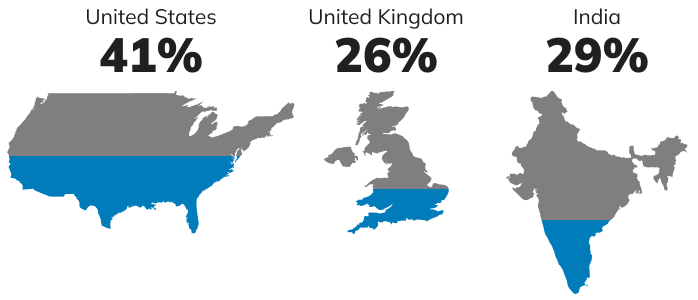Planning for the Future: The Rise of the Agile Marketer
B2B Marketers Take On More Responsibilities to Power Success

"Change is inevitable, growth is optional."
— John C. Maxwell
This famous saying by leadership expert John C. Maxwell has long challenged leaders to embrace change and grow to meet it. New findings about B2B marketers show that many are growing to meet the inevitable change, and the more strategic their growth, the more successful they are. This report zooms in on those marketers who answered “yes” in our 2025 global B2B marketing survey when asked if they had taken on new responsibilities this year. These are the Agile Marketers—and they’re showing us what’s next. These findings point to the strategies and tactics B2B marketers need to get ahead.
We found in our recent global B2B marketing survey that 79% of B2B marketers have taken on new responsibilities, and it’s paying off. Added responsibility is most often found in companies experiencing revenue growth and marketing success, rather than in those facing declines. One major area of change is the job description itself. Marketers of all levels and disciplines are expanding their areas of expertise and rising to meet challenges across a larger span of responsibility, including more strategic planning, sales support, and analytics. From senior leaders to specialists, these agile marketers confidently embrace data, which fuels technologies including AI, new measurement methodologies, and new approaches for effectively reaching prospects and customers.
Looking ahead, marketers with a range of skills and responsibilities are best positioned for success. Consider the many uncertainties B2B marketers face:
- Tariffs, price increases, and buyer caution
- The rise of AI, which is already changing the digital buyer journey
- Larger buying groups and shifting stakeholder personas, including more Gen Z and Millennial decision makers
- An increasingly data-led marketing landscape, which requires more technical and analytical expertise
Having broad capabilities to draw on means B2B marketers are prepared to shift and evolve as needed.

Taking charge of the digital (AI) future
The world of B2B marketing changed forever during the Covid-19 pandemic, when marketing shifted from in-person events, face-to-face meetings, and direct mail to offices to digital channels. Buyers have embraced a more online buying journey and have not looked back. There has also been a generational shift, with most decision makers now coming from the digital-native Millennial and Gen Z generations; these buyers have always been comfortable transacting online and researching solutions on social, video, and via peer networks.
Marketers must be even more agile when planning marketing campaigns to address the new buying journey.
Planning for future marketing success
Digital Customer Journeys — Forrester notes that, as a large percentage of B2B buying moves online, many customers will want a more “self-service” journey.1 This requires major marketing orchestration and support, from website management to demand generation to customer experience optimization. AI will only turbo-charge this trend, requiring B2B marketers to move quickly to build the systems, data foundation, and agility needed to deliver personalized, AI-powered, self-service customer journeys at scale.
Sales and Marketing Alignment — Many aspects of supporting and optimizing a digital customer journey suit marketing more than sales. Gartner states, “The likelihood of strong commercial growth increases with sales and marketing alignment. A Gartner survey of 632 B2B buyers from August through September 2024 found that B2B buyers are completing purchases through different channels, underscoring the need for a less siloed approach.”2 Rather than simply handing leads off to the sales team, marketing is becoming more deeply intertwined with sales and sharing more goals. This requires a more scientific approach to marketing, including an increase in the use of data, targeting, measurement, and analytics.
Shifting Tactics and Technologies — Evolving buyer preferences also impact how marketers approach customers and prospects. Marketers are testing a more complex marketing mix that includes social media, CTV, self-service platforms, events, email, search, display, and more. At the same time, AI is turning many marketing processes upside-down, as it is used to create content more efficiently, analyze data, and predict outcomes. Team members must be agile, using new data and technologies while embracing new strategies and tactics.
By the numbers: smarter work will drive growth
Our survey finds that most marketers who have embraced change in the past year focused on measurable, revenue-oriented work, including driving revenue growth, improving customer acquisition rates, and supporting sales with qualified leads and insights.
Marketers taking on new responsibilities are also working on enhancing brand awareness and managing, optimizing, and adopting marketing technology.
We found that these agile marketers who embrace new responsibilities aren’t just working harder, they’re working smarter with sharper tactics. They are nearly twice as likely to use AI as others (42% vs 24%), and they are more likely to use it to personalize campaigns, analyze performance, and save time. Agile marketers are also connected to other teams and focused on driving sales. They are more likely to support sales with qualified leads and insights (54% vs. 39%), showing the importance of aligning with sales to drive revenue. They also manage complex martech stacks and drive cross-functional alignment.
|
Marketers’ self-reported contributions to organizational goals |
I took on new responsibilities |
I did NOT take on new responsibilities |
|
Driving revenue growth through marketing initiatives |
66% |
57% |
|
Managing, optimizing and adopting marketing technology |
58% |
45% |
|
Improving customer acquisition rates |
57% |
51% |
|
Enhancing brand awareness and market positioning |
55% |
55% |
|
Supporting sales with qualified leads and insights |
54% |
39% |
|
Creating cross-sell and/or upsell programs to retain and grow customers |
48% |
37% |
|
Optimizing marketing ROI and resource allocation |
48% |
45% |
|
Leveraging data and analytics to inform strategic decisions |
45% |
35% |
|
Aligning cross-functional teams toward shared goals |
39% |
24% |
|
Developing and executing demand generation campaigns |
37% |
22% |
|
Other |
3% |
3% |
Agile marketers save time with AI. 58% say it improves efficiency—nearly double their peers.
Want to work smarter? Start by automating the time drains that slow campaigns down.
Even as agile marketers double down on data, tech, and performance, they’re not walking away from brand marketing. In fact, they’re just as invested in building brand awareness because they know it fuels long-term growth. Research3 makes that value clear: brand marketing isn’t a nice-to-have; the investment in it delivers “trust, connection, and loyalty” and “advances relationships to commitment.”
Agile marketers are also much more likely to be data-savvy, with 69% using first-party data compared to only 47% of other marketers. They use more intent data broadly across channels and are significantly more likely to allocate much of their budget to testing. Agile marketers are considerably more focused on driving revenue growth through marketing initiatives, which goes hand in hand with testing.
Preparing for strategic growth ahead
You might expect tough times to be the driver of additional marketing responsibilities, but the data tells a better story: an increase in marketing responsibilities is based on success, and positions B2B marketers for the future as these marketers will have more skills to draw on in the face of uncertainty.
We looked at how increased marketing responsibility aligned with revenue growth. We found that marketers who took on more responsibilities were more likely to be at companies with a significant revenue increase. This is a sign that as companies grow, marketing becomes more, not less, critical to the organization.
Senior marketers embrace strategic responsibility
Another pleasant surprise in our analysis was that senior marketers are ahead of their more junior peers in taking on new responsibilities. While every level saw an increase in responsibilities, the executives’ scope increased the most. This makes sense when analyzing the new responsibilities most likely acquired in the past year, many of which are strategic, including team alignment and revenue focus.
Agile marketers' current job levels

Identifying regional trends
Most marketers took on new responsibilities across every region we surveyed in the past year. Countries in APAC stood out for their above-average revenue growth, especially India. Supporting our findings, The Trade Desk’s news publication, The Current, called 2025 “the Year to Watch India.”4 They note the high revenue growth of digital channels, including CTV, which creates new opportunities for B2B marketers to create value.

Embracing change, enhancing growth
Marketers with new responsibilities tend to be at companies and organizations that are more likely to be thriving, and these are the marketers who show us the way to success. In addition to revenue and pipeline growth, agile marketers have a notably stronger outlook on the future. In fact, 97% express a positive outlook on their marketing success, with 59% feeling extremely positive. These marketers aren’t just adapting—they’re energized and ready to lead. The best of these marketers will build teams with specific data, analytics, and content strategy skills, who can also adapt and take on new responsibilities.
B2B marketers are showing their ability to act as key players at companies experiencing revenue growth, which is something to lean into as we move into the future. Rather than creating a marketing strategy based on highly predictable events, agile B2B marketers can manage volatility and future unknowns using testing, data, technology, and analytics.

Winning formulas for your marketing strategies:
- Embrace new responsibilities as a challenge to be met, not a burden to bear
- Incorporate AI and data into all planning and execution
- Work closely with C-levels and sales to align on goals
- Be laser-focused on changes to the customer journey and understand shifting buyer behavior
- Hire “T” shaped team members with the ability to take on a variety of challenges across marketing while also having expertise in a particular function
For any B2B marketer looking for encouragement to expand their scope, embrace data and AI, and test new tactics, this research certainly points to opportunities rather than risks. As long as these actions are aligned with company growth goals and sales efforts, growing marketing’s scope seems to be a winning ingredient in growth organizations.
About this Data
This report focuses on a specific group of marketers uncovered in The 2025 B2B Marketing Edge: those who answered “yes” to taking on new responsibilities in the past year. We’ve referred to them throughout as agile marketers, not as a new persona, but as a strategic segment defined by how they’re evolving:
- Expanding their influence
- Embracing data and AI
- Driving growth across teams and tactics
This report was designed to help B2B marketing leaders understand what’s working among their most agile peers and to provide actionable insights for clearly and confidently planning for the future. To explore the additional data —including how Growth Gurus and Data Heroes are setting the pace—visit anteriad.com/marketingedge.
Sources
1 Forrester Research, “Self-Service Buying Is A Wake-Up Call For B2B Sales,” Rick Bradberry, Principal Analyst, June 3, 2024
2 Gartner, “Three Trends Chief Sales Officers Must Consider in 2025,” Robert Blaisdell, December 9, 2024
3 Forrester Research, “Brand Is A Long Game: The Tangible Value Of B2B Brand Investments,” Karen Tran, Principal Analyst, May 3, 2024
4 The Current (The Trade Desk), “Why India is the market to watch in 2025,” December 5, 2024
